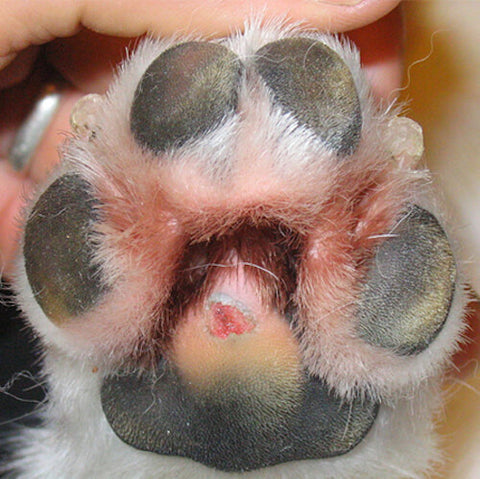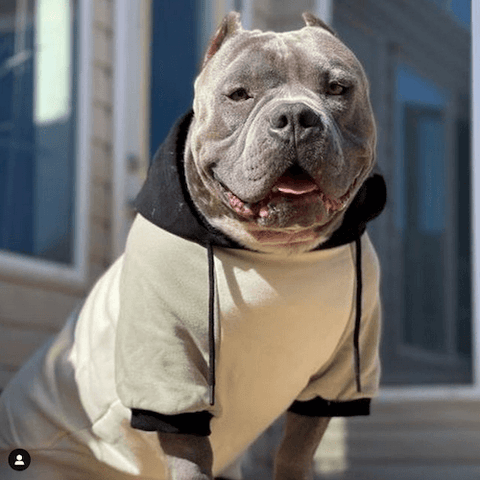How to Keep Your Pet Comfortable During Winter
To ensure your pet’s comfort and well being during the winter season, here are 10 tips you should keep in mind as a responsible pet parent:
1) Keep dogs sheltered.

Juliet the English Bulldog keeping warm in her peach ribbon and Cotton Candy Dog Hoodie.
Winter temperatures of 20°F could cause potentially fatal health issues like frostbite and hypothermia, but pet owners should watch their dogs closely as temperatures drop to 32°F. In fact, short-coated and cold-averse breeds already become uncomfortable when temperatures approach 45°F.Additionally, companion dogs thrive best when they can stay indoors and take part in everyday family activities. If you have an outdoor dog, consider keeping them inside at least until the temperature gets warmer. You can always use pens or fencing if you need to keep them away from certain areas of the house.
If you do have to keep dogs outside, always keep an eye out on the weather and make sure they have ample shelter and. A dog house with proper insulation should help keep them warm. Check on them as frequently as possible to make sure they don't get too cold.
2) Suit up in warm dog apparel.

The Amstaff Pack keeping warm in the Clouds Knit Dog Sweater in blue.
Many dogs aren’t made for winter weather and will need some help to keep warm when temperatures drop. Be extra vigilant if your dog has a short coat because they might not have the natural insulation they need.Apart from their coat, dogs rely on their respiratory system to regulate their temperature. Just like humans, dogs can develop sniffles due to the cold and dry weather. You might notice watery eyes, wet sneezes, and lack of energy.
But when the air gets icy and the dogs get too cold, this can lead to something more serious, like pneumonia. Additionally, their compromised immune system makes them more susceptible to bacterial and viral illnesses like canine influenza and kennel cough.
Dog sweaters and coats aren’t just adorable but are actually functional. For winter, the dog clothes you buy should cover the entire body from the neck up to the base of the tail. Make sure your dog’s belly is also protected.
3) Protect their paws.

A dog’s paws showing signs of frostbite due to prolonged exposure to snow. (Source)
Dogs can suffer from frostbite when temperatures drop below 32°F. Consider using dog boots if you’re taking your dog out to walk on icy pavement. Apart from protecting from frostbite, booties will provide extra traction so they can walk more comfortably and minimize the risk of injuring themselves on slippery ice.If your pup won’t tolerate shoes, you can apply paw wax before heading out. You should also make the habit of wiping your dog’s paws before going indoors and inspecting all the pads for signs of irritation.
4) Watch for poisons.

A pitbull suffering from antifreeze poisoning experiences weakness, seizures, vomiting, and delirium. (Source)
Several toxic substances are of concern during the winter. Toxic snow salts are widely used to keep roads and walkways from becoming dangerously slippery.These are strong enough to cause skin irritation and even chemical burns on the paws.
Additionally, substances can leak from radiators and cause antifreeze poisoning. Dogs that accidentally consume even a small portion of this can become lethargic and even suffer from kidney damage.
But toxic substances don’t just come in the form of harsh chemicals. There are also chocolates, candy bars, and other goodies that can be more abundant as the Christmas season approaches. Familiarize yourself with common foods that are toxic to dogs and make sure you keep them out of paw’s reach.
Apart from keeping a close eye on them when outdoors, make sure you wipe them down before letting them inside. Doing so removes snow from their fur and enables them to warm up sooner.
You can also opt for dog hoodies that will cover not just your dog’s torso but also their head. This will protect their coat and skin, and will make sure they don’t bring in outside dirt and potentially toxic substances inside your home.
5) Use a harness outdoors.

Mr. Zeus Almighty ready for a winter walk with the Yogawear Harness Set in blue.
If you’re going out for a walk, use a dog harness rather than a collar. This will provide extra insulation as it covers more areas of the body. Additionally, these can be worn below or on top of other dog clothing for even more protection from the cold.Harnesses are especially useful if you have a brachycephalic dog like a pug or a Frenchie. Such dogs have more difficulty breathing and regulating their temperature because of the short muzzles. So, harnesses are better than collars, especially in extreme temperatures.
6) Inspect play areas.

Kachalo the Frenchie enjoying the outdoor deck in his Broken Teddy Bear Knit Dog Sweater.
If you’re leaving your dog to play in your yard or even off-leash at a nearby park, make sure you inspect the premises for safety. Some surfaces may be too slippery due to ice and snow, and some areas might be treated with harsh snow management chemicals.
Additionally, exposure to ice and snow can cause wood and similar materials to rot. Broken play areas can cause serious injury while damaged fencing can cause your pup to run off.
Related: 10 Fun Things To Do With Your Dogs at Home
7) Ensure proper hydration.

The bullies of Coco Kaboo in matching Bad & Boujee Dog Hoodies.
Although dehydration is usually a summer concern, proper hydration is still essential during the cold season. Always make sure your dog has a bowl of fresh water to drink from. If you’re keeping them outside, check on the bowl every few hours to make sure the water hasn’t iced up.Additionally, dogs are usually lazier in cold weather and it’s common for them to drink less simply because they don’t want to get up. If you think your dog is not drinking enough water, you can entice them with the occasional bowl of unsalted broth.
8) Don’t overfeed.

Thor the Beast Bully keeping in shape and looking extra handsome in his Olive Cream Dog Hoodie.
Because dogs are usually not as active in the winter as they are in warmer months, they don’t burn off the same amount of energy. Try to keep a close eye on their weight. Chances are, they’ll gain some fat during this season and it’ll be your responsibility to keep them at a safe and comfortable weight.Keep an eye on your dog’s food intake. If you find that they’re quickly ballooning, you can lessen their food while they’re not too active. Also, limit the number of treats you give them as these can contribute to winter obesity.
9) Pet-proof heat sources.

Bauer the Mini Aussie wearing his Cuban link chain and jewelry dog tag in front of the fireplace.
It’s natural for dogs to seek out warmth when they’re cold. However, there’s always a risk that they might stay too close to heat sources and hurt themselves. Inside the home, limit their distance from space heaters.
Baseboard radiators are generally safe for dogs, but you should install a cover to keep them from getting too close. If you have a fireplace, you should also limit how close your pets can get to minimize the risk of burning.
10) Provide cozy bedding.

Maxi the Grey Frenchie fast asleep in the Teddy Sherpa Fleece Dog Jacket in brown.
Although some dogs prefer sleeping on the floor, the ground can get too cold during the winter. Make sure you give your pup access to cozy bedding that they can snuggle in for a good rest.
A raised dog bed will keep your dog’s body away from the cold floor but might not have insulating properties like beds with fiberfill. Make sure you choose the dog bed wisely for your pup’s optimum comfort. Depending on the temperature, you can also add some blankets or send them to bed in dog jumpers to make sure they’re warm and toasty.
Although small, short-coated breeds are most at risk of these issues, remember that big dogs can feel miserable during the winter as well. Make sure you observe your own dog for signs of discomfort, especially if they are older and prone to joint aches.
For an extra layer of warmth and protection, check out Sparkpaw's range of onesie dog pajamas.
It’s true that the winter season brings with it some dangers. These may cause anything from minor discomfort to a serious health condition. But don’t let that keep you from enjoying once-a-year opportunities the colder weather brings. It’s helpful to learn how to tell if your dog is feeling cold and step up your game in ensuring they feel warm and cozy.
